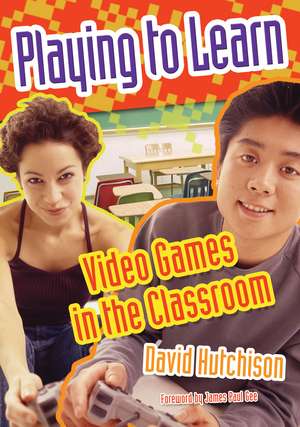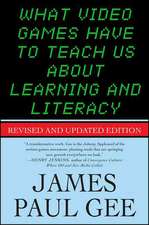Playing to Learn: Video Games in the Classroom
Autor David Hutchisonen Limba Engleză Paperback – 29 mai 2007 – vârsta până la 17 ani
Preț: 202.66 lei
Preț vechi: 260.49 lei
-22% Nou
Puncte Express: 304
Preț estimativ în valută:
38.78€ • 42.11$ • 32.58£
38.78€ • 42.11$ • 32.58£
Carte tipărită la comandă
Livrare economică 22 aprilie-06 mai
Preluare comenzi: 021 569.72.76
Specificații
ISBN-13: 9781591584926
ISBN-10: 1591584922
Pagini: 280
Dimensiuni: 178 x 254 x 18 mm
Greutate: 0.59 kg
Editura: Bloomsbury Publishing
Colecția Libraries Unlimited
Locul publicării:New York, United States
ISBN-10: 1591584922
Pagini: 280
Dimensiuni: 178 x 254 x 18 mm
Greutate: 0.59 kg
Editura: Bloomsbury Publishing
Colecția Libraries Unlimited
Locul publicării:New York, United States
Notă biografică
David Hutchison is an Associate Professor in the Faculty of Education, Brock University. He is the author of Growing Up Green: Education for Ecological Renewal and A Natural History of Place in Education.
Cuprins
Foreword by James Paul GeeAcknowledgmentsIntroductionAdvertising CampaignThe students design a full-fledged advertising campaign for an upcoming or newly released video game.Alternate HistoryThe students write an alternate history of the world that starts with a decisive change in the outcome of a historical event.Arcade vs. Video GamesThe students compare and contrast the social experience of playing video games in an arcade versus playing them at home on a video game console or PC computer.Artistic RenderingThe students create an artistic representation of a real-world scene.BattleshipThe students assemble the materials for a classic game of Battleship, which they then play in pairs.Best Kids' GameThe students rank and review their favorite kid-friendly video games.Body ImageThe students discuss the relationship between body image and the physiques of both male and female video game characters.Discussion Article: Lara Croft: Tomb Raider Series by Ismini Boinodiris RobyBook ReviewThe students review an academic or instructional book about video games.Branding the BoxThe topic of branding is introduced to students who then compare and contrast the packaging of two or more PlayStation 3, Wii, or Xbox 360 titles.BullyThe students discuss the ethical issues surrounding RockStar's school-based video game titled Bully.Discussion Article: Video Games May Dull Shock at Violence by Miranda HittiCar CommercialThe students create a car commercial using in-game footage captured from a driving game.Car of the FutureThe students design and outline the specifications for a tricked-out new car (or flying machine) of the future.Chart ToppersThe students track the video game sales charts over a one-or two-month period. They analyze and draw conclusions about the statistics they have collected.Cheat Code CentralThe students review a game's cheat codes. They propose a revised set of cheat codes that would make the game easier and more fun to play for novices and recreational gamers alike.Choose Your Own AdventureThe students write a choose your own adventure story, a narrative with multiple pathways that can then be adapted for use in an adventure video game.Composer DiscographyThe students research the discography of an established video game composer.Critiquing the ControllersThe students compare and contrast the gamepad controllers that ship with the Microsoft Xbox 360, Nintendo Wii, and Sony PlayStation 3 gaming systems.Deadpan DialogThe students write a review of a video game focusing solely on the elocution of one or more characters' dialog.Design Your Own RacetrackThe students use arts and crafts supplies to design a racetrack that features five or more geographic landforms.Design Your Own Racetrack (Take Two)The students use a city map to design a sanctioned street race through an urban center. They identify road hazards, plot positions where protective barriers should be erected, and mark off cross streets that should be closed to traffic.Do You Recognize This Voice?The students play a teaching game in which they listen to recorded excerpts of dialog from several video games. They attempt to guess which celebrity's voice they are hearing.Discussion Article: Ethics in Video Game Journalism by Justin HallDon't Believe the HypeThe students compare and contrast the previews and reviews of a video game. They look for evidence of hype in the previews for games that didn't quite fulfill expectations upon their release.ESRB Ratings ReviewThe students review the ESRB ratings system and suggest what changes (if any) they would propose making.Ergonomic AuditThe students conduct an ergonomic audit of the school's computer lab. They present their findings to the student council, principal, and school staff.Fact vs. OpinionThe students analyze and parse one or more reviews of a video game for statements of fact and opinion.Discussion Article: Reality Bytes: Eight Myths about Video Games Debunked by Henry JenkinsFine Motor CountThe students tally the number of times one or more gamepad buttons are pressed during a gaming session. They then transfer this data onto a chart for further analysis during math class.Fitness RegimeThe students propose a series of fitness exercises for a leading video game or comic book character.Discussion Article: Exercise, Lose Weight with "Exergaming" by Star LawrenceFoley Effects ArtistThe students become Foley artists as they replace the sound effects in a video game with their own sounds derived from materials they have collected in and around their school and home.Foley Effects Artist (Take Two)The students add Foley effects to their game creations and video productions.Discussion Article: Soaking Up the Media: Full-time Job for Kids by Miranda HittiFor How Long Do I Play?The students track the amount of time they spend playing video games over a two-week period. They then analyze and perform calculations on the data they have gathered.Game InventionThe students design a real-world game or sport that they then teach others to play in a physical education class.Gaming BudgetThe students perform a cost-benefit analysis of the practice of buying versus renting video games.Gaming StationThe teacher sets up a PlayStation 3, Wii, or Xbox 360 gaming station in the classroom that is to be used for educational purposes in the instructional program.Graphical AnalysisThe students conduct a graphical analysis of a video game. They critique the models, textures, lighting, shadows, and other graphical features of the game.Historical CampaignThe students propose a new mission for an existing World War II-or Vietnam-based wargame. They draw their idea from an actual historical campaign or scenario that occurred during the war.Historical Place AnalysisThe students compare and contrast historically accurate video game environments with photographs and descriptions of the same real-world settings.Discussion Article: The Convention for the Protection of Virtual Architectural Heritage by Mario Gerosa, with the collaboration of Sam ShahraniHistorical WeaponryThe students research the history of a weapon that is featured in a World War II-or Vietnam-based video game.I Beg to DifferThe students write a response to a negative review of a video game they enjoyed.I BelieveThe students write an I Believe poem about video games that comprises ten belief statements.Discussion Article: Contradictions by Richard BartieKid-friendly Grand Theft AutoThe students take back the streets as they design a vibrant, kid-friendly city in which there are lots of things to do.Lay of the LandThe students create a topographic map of a fictional battlefield that features several of the landforms they have studied in class.Map of the WorldThe students use a wall map of the world to plot the real-world locations in which their favorite video games are set.Music CriticThe students critique the licensed musical mix that is featured in a video game.New Multiplayer ModeThe students brainstorm new multiplayer modes that comprise sets of gameplay rules and scenarios for a popular online wargame.Newscast ProductionThe students study the structure of a traditional television newscast. They then apply what they have learned to the creation of a live newscast of their own that reports on the video game news of the day.Discussion Article: Why We Need a Corporation for Public Gaming by David RejeskiNext Generation ConsoleThe students pick a name and design a model for a next-generation gaming system. They also brainstorm a list of cutting-edge features that the system will support.Open World DirectionsThe students write out the directions for getting from Point A to Point B in an open world driving game.Playing to LearnThe students brainstorm and lead their own video game learning activities.Poor PostureThe teacher presents a lesson on ergonomics in which a student volunteer demonstrates the proper posture for sitting at a computer.Race RelationsThe students discuss how different cultural groups are represented in video games.Repetitive Stress InjuryThe teacher presents a formal lesson on repetitive stress injury to the class.Discussion Article: Protect Kids from Computer Injuries, Safety Council Urges by the Canadian Broadcasting CorporationResearching the CreditsThe students research a specific video game-related job and its role in the development of a video game title.Researching the Credits (Take Two)The students browse the credits for one or more video games as a way of helping them to organize their own in-class game development studio into assigned roles and tasks.Review RoundupThe students compare and contrast two or more reviews of a video game. They write a review roundup that sums up the views of the critics plus their own insights.Review of the Real WorldThe students turn the notion of a video game review on its head and instead review the real world as if it were a video game.Discussion Article: Real Life: The Full Review by Greg KasavinScary StoriesThe students discuss what makes a story, movie, or video game scary. They then write their own scary story.Scooby-Doo and the Laws of PhysicsThe students watch a half-hour Scooby-Doo Mysteries episode and count and/or categorize the number of times the characters-both friends and foes-do the impossible.Serious Games BrainstormingThe students brainstorm ideas for a new serious game that teaches the knowledge and skill set required by a particular profession.Discussion Article: Video Game Therapy: A New Frontier by ReutersSpelling DictationThe teacher compiles a spelling list of video game-related terms.Statistical AnalysisThe students analyze and discuss a number of video game-related statistics.Strategy Guide ReviewThe students write and then publish a review of a video game strategy guide.Strategy Guide WritingThe students author their own strategy guides for a full video game or a single mission from a favorite game.Study of the FutureThe students write an essay that predicts what our world will look like in the future.Discussion Article: Laura's Story by David HutchisonSuperhero DesignThe students design an original superhero character for a video game.Surround Sound MapThe students go outside and draw a directional sound-field map that plots the location of natural and human-made sounds coming from the front, rear, sides, and overhead.Tactical AnalysisThe students write about one or more tactics they have successfully used in a video game.Technological ProgressThe students review the graphical features of three video games, respectively published this year, three years ago, and six years ago.Television TechnologiesThe students research the science behind the four major television technologies: CRT, LCD, DLP, and plasma. They report on the pros and cons of each.Test DriveThe students design a science experiment in which their peers take the cars in a racing game for a test drive. They report on which cars have the best and worst control and handling according to the participants in the study.The Gaming PCThe students design the casing for a custom gaming PC that optionally features a custom paint job, decals, neon lights, tattoos, and other embellishments.The InterviewThe students interview their peers about their video game playing habits. They then draw tentative conclusions from the data they have gathered.The ObituaryThe students write an obituary that recounts the life of a lead video game character who has died.The PitchThe students prepare a proposal for a brand-new video game, which they then pitch to the class.Discussion Article: Bringing Back the Dream by Noel LlopisThe RewriteThe students rewrite the dialog for a cutscene in a video game that is in desperate need of improvement.The Rewrite (Take Two)The students rewrite a video game user review in an effort to improve its clarity and sentence structure.The StuntThe students capture some in-game footage of their characters performing insane stunts on foot or in vehicles.The SurveyThe students design a video game survey, which they then administer to other students in the school.Ultimate Gaming BundleThe students design an advertisement for the ultimate gaming bundle, consisting of a PC or console system and third-party hardware and games.Urban PlanningThe students choose the location for a new city, which they then design from the ground up.User Interface ReviewThe students apply the principles of user interface design to their review of a game's user interface, menu system, and/or heads up display (HUD).Video Game AddictionThe students research the topic of video game addiction. They decide on a list of criteria for determining whether someone is addicted to video games.Discussion Article: Doctor Claims 40 Percent of World of Warcraft Players Are Addicted by Jeremy ReimerVideo Game DatabaseThe students design a database for storing information about video games. They pretend they are opening a video game rental store and need to keep track of their inventory.Video Game DebateThe students debate a controversial issue related to video games.Discussion Article: Massacre in Winterspring by Gabe GrazianiVideo Game ReenactmentThe students reenact a key scene from a video game that boasts a strong storyline.Video Game ReviewThe students write a review for a video game they are currently playing.Discussion Article: Living in Oblivion by Jane PinckardVirtual JournalThe students write a series of journal entries that chronicle their virtual life in an online role-playing or open world video game.Discussion Article: Are Virtual Worlds the Future of the Classroom? by Stephanie OlsenWebsite DesignThe students brainstorm ideas for a video game website that features content not typically found at existing websites.Well-Balanced DietThe students propose a set of four video games that provide a desired gameplay balance and variety of play.World without MusicThe students reflect on the perceptual experience of playing a video game without music.World's Best GamertagThe students are challenged to come up with the most creative Gamertag they can think of.Afterword: Video Game Design in the ClassroomActivity List Sorted by SubjectIndex
Recenzii
More than 100 video game activity ideas for grades 4 to 12 are included in this volume that helps teachers integrate the study of video games into the classroom..For each exercise, a brief background is provided, the activity is explained, and follow-up discussion ideas are offered..Teachers could aos use some of these activities as viable reserach topics for students.
Hutchison has written this guidebook to help teachers integrate the study of video games into classroom practice..Hutchison provides a valuable, concrete way of engaging students in reading and writing by integrating a ubiquitious aspect of popular culture into classroom practice..Highly recommended. This book can form the core of interesting exploration and implementation by professional learning groups in your school. As well, it offers new opportunities for school library-classroom collaboration.
The author does not envision a classroom where computer games can be played, but one where students will be analyzing, designing, and creating films using video game footage. The book is designed to be used in traditional classrooms where teachers will use their students' familiarity with video games as a stepping stone to teach higher order thinking skills. This also can be used in classrooms where students will discuss, research, and write papers on the various topics raised about video games. The book is arranged alphabetically by activities. Each activity has a brief introduction, description, discussion, grade level, and subject area. For educators wanting a different approach to teach various traditional skills in the various disciplines, this would be a good purchase.
Hutchison has written this guidebook to help teachers integrate the study of video games into classroom practice..Hutchison provides a valuable, concrete way of engaging students in reading and writing by integrating a ubiquitious aspect of popular culture into classroom practice..Highly recommended. This book can form the core of interesting exploration and implementation by professional learning groups in your school. As well, it offers new opportunities for school library-classroom collaboration.
The author does not envision a classroom where computer games can be played, but one where students will be analyzing, designing, and creating films using video game footage. The book is designed to be used in traditional classrooms where teachers will use their students' familiarity with video games as a stepping stone to teach higher order thinking skills. This also can be used in classrooms where students will discuss, research, and write papers on the various topics raised about video games. The book is arranged alphabetically by activities. Each activity has a brief introduction, description, discussion, grade level, and subject area. For educators wanting a different approach to teach various traditional skills in the various disciplines, this would be a good purchase.











